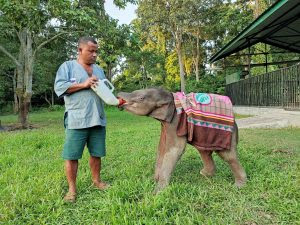ORPHANED ELEPHANT CALF OF DHOLAGAON
Elephant deaths due to electrocution are not a new thing for India. An RTI reply from the Ministry of Environment, Forests and Climate Change to activist K. Govindan Namboothiry informs that about 474 elephants have died across India due to electrocution in the past six years and there seems to be no end to the loss. The number for 2018 alone is 81.The Wildlife Trust of India says that a heart-touching latest incident comes from Dholagaon in Assam. This time, it was a lactating mother that died when a high voltage wire fell on the individual as the herd was making its way across a crop field. Dr Samshul Ali, from the Centre for Wildlife Rehabilitation and Conservation, who did the post mortem informs, says that “During necropsy we were disheartened about the lactating mother. Locals informed us that the baby had left with the herd. From past experience, we advised the forest officials to keep looking for the baby. Four days later the abandoned baby was seen in the Miripathar area as it probably could not travel with the herd alone after the death of the mother.”
Witnesses confirmed that the herd had tried to take the three-months-oldcalf along after the death of its mother. But babies such young are completely dependent on their mother, for both nutrition and protection (with support from other matriarchs in the group). For a highly intelligent and social animal, losing the mother must have been a devastating experience for the baby male. The post mortem report showed that the mother was between 15 and 18 years of age. There’s a high probability that this was a ‘first time mother’ since Asian elephants mature at about 14 years of age. Primary witnesses say that the calf couldn’t keep up with the rest of the herd and was eventually abandoned by the next day. On the fourth day, the 28 of October, the calf had made its way back to Miripather where its mother had died.
Colonel Gill Dies Short Of 101st Birthday
Three days before the death of India’s first Chief of Defence Services General Bipin Rawat (63) and 12 others, including his wife Madhulika (Princess of the erstwhile Royal State of Shahdol in Madhya Pradesh), the country lost another great soldier Colonel (retired) Prithipal Singh Gill. While Gen Rawat became the “Boss” of all the three services after his retirement, Col Gill had the unique distinction of having served in all three branches of the armed forces as well as the para-military forces. He died in Chandigarh last Sunday, just a week short of his 101st birthday. Gill was born in Patiala in 1920. While Gen Rawat—the man from the hilly state of Uttrakhand—died in the Nilgiri hills, always smiling Gill’s long journey ended at his home itself. A World War-II veteran, Gill is survived by his wife Preminder Kaur, a son, three grandchildren and three great-grandchildren. His son Dr Ajaipal Singh Gill told The Sunday Guardian, “My father lived the way he wanted to.”
Gill had done his graduation from Government College, Lahore, and later took up flying as a passion at Walton Aerodrome in Lahore from where he earned a flying licence. Later, he joined the RIAF in 1942 and was training as a Flying Cadet at Karachi, flying Howard aircraft when his father, Major Harpal Singh Gill, withdrew him from training because the family considered flying to be unsafe. Gill, then 23, thereafter joined the Navy where he served on a mine sweeping ship, INS Teer, which was an escort for cargo ships during WW-II.
Indian ‘Shooters’ in Jerusalem!

Photo: Prabir Purkayastha
Recently, on the occasion of Hanukkah, the Israeli Embassy organised a photo exhibition that visually narrates the cultural history of Israel’s ancient capital Jerusalem through the camera lenses of three Indian photographers. Hanukkah is a Jewish festival that reaffirms the ideals of Judaism and commemorates in particular the rededication of the Second Temple of Jerusalem by the lighting of candles on each day of the festival. Titled
“Transcending Jerusalem”, the exhibition presents works of Indian photographers who captured the images of the Holy City from their perspectives. The photo exhibition, curated by Dr. Alka Pande, is open to the public till 15 December at Museo Camera Centre for the Photographic Arts, Gurugram. The Israeli Ambassador Naor Gilon told The Sunday Guardian: “This exhibition is an opportunity to share the beauty of the 3000-year-old capital of Israel through the eyes of Indian photographers, a city that means so many things to so many people around the world. I hope this will inspire visitors to visit Jerusalem and discover what it means to them”. The three Indian photographers—Prabir Purkayastha, Parthiv Shah and Aditya Arya—have narrated the vibrant, multi-layered identity of the Holy City through their visual works in this exhibition. Each visitor to the exhibition will see a different aspect of Jerusalem.

